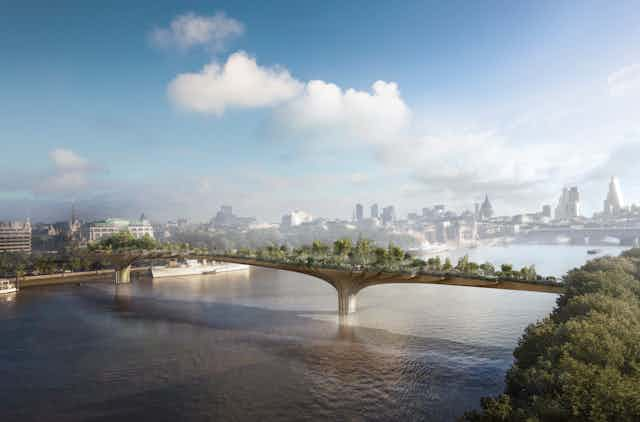Rarely has a project to bring a city together been as divisive as London’s Garden Bridge. Conceived by British actress Joanna Lumley and championed by the city’s previous mayor, Boris Johnson, the Garden Bridge is billed as “a stunning new public garden and a vital new pedestrian crossing, spanning the River Thames from the South Bank to Temple station on the north bank”. But opposition to the project was fierce from the beginning, and it continues to intensify as public funds are put at stake.
The development of the Garden Bridge cuts to the core of current debates about the provision, cost and role of green spaces in our cities. Green spaces are central to “liveability”; they provide health and well-being benefits, aid urban climate control, promote biodiversity and can have significant impacts on property prices. Parks also have a clear role as places for social interaction, recreation and environmental education.
Given these benefits, it might seem like any investment in green space should be welcomed. With plans for hundreds of trees and thousands of plants, supporters of the Garden Bridge say it will be both beautiful and functional – an extraordinary place to relax, observe or “race across”.

But campaigners raise several objections. For one thing, they say the project lacks transparency and questions have been raised regarding the fairness of the design competition and procurement process, as well as the influence exerted by celebrities and prominent architects.
Critics have also argued that the proposed location is already well serviced by bridges (albeit not “garden” ones), with Waterloo Bridge fewer than 400 metres from the site. What’s more, there are other locations – east of Greenwich, for instance – which would benefit more from a cross-Thames connection, while cheaper alternatives would reclaim existing infrastructure, in the style of New York’s famous High Line – for example, Allies and Morrison’s proposal for a garden on Blackfriars Bridge.
Finding the funding
As local authorities confront austerity budgets, funding for parks and gardens is often one of the first things to be cut. As a result, many local governments are seeking to establish alternative sources of income – such as the privately-owned playground Go Ape in Battersea Park, south London. This prompts the question: can we justify developing new green spaces, when the costs of maintaining existing ones is already overwhelming?

The Garden Bridge is expected to cost £185m, the bulk of which is to come from £125m worth of private donation, with a further £60m of public funding from Transport for London and the Department for Transport.
London Mayor Sadiq Khan has given assurances that no more public money will be dedicated to the scheme. But with somewhere between £56m and £75m worth of private donations still to be sourced, there are concerns that further requests for funding will be put to the government.
In response to concerns over the costs of the project, Khan ordered an inquiry into whether the bridge offers good value for money. But cancelling the project would not come cheap, either: a recent investigation by the National Audit Office (NAO) found that roughly £22.5m worth of public funding could be lost, if the project doesn’t proceed.
A public good?
The question of who should pay for the bridge has a lot to do with ownership. The Garden Bridge will by administered by a trust, rather than a public authority, so the government will have little control over how the taxpayer’s money is spent. It also means that the bridge will not be a truly public space. Instead, the trust will have the power to close the bridge for private events throughout the year, and dictate how the bridge is used – so far, the list of unacceptable activities include cycling, playing an instrument and flying a kite.

Even so, the Garden Bridge would deliver some of the key benefits of green spaces – and it’s not necessarily as bad a design as some campaigners believe. The project could generate financial, political and social buy-in for a new, green public space, just like London’s Olympic Park did. We cannot ignore such landmark developments – and in fact, we may need them if we are to keep maintaining and expanding green public spaces in our cities.
But there is a difference between developing spaces that people can freely enjoy, and designing quasi-private spaces that limit the activities, times and numbers of people allowed in. Historically, public parks have been welcoming and open to all, without imposing major limitations on how people interact with them: we should aim to maintain the ethos of accessibility, functionality and diversity for our green spaces.

